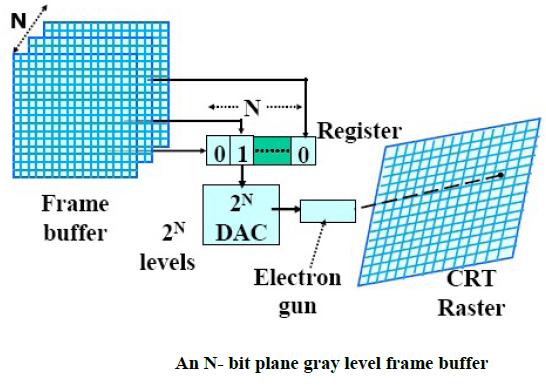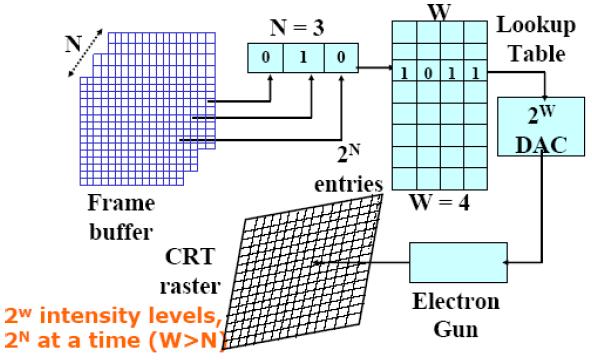A frame buffer is a large, contiguous piece of computer memory. At a minimum there is one memory bit for each pixel in the rater; this amount of memory is called a bit plane. The picture is built up in the frame buffer one bit at a time.
You know that a memory bit has only two states, therefore a single bit plane yields a black-and white display. You know that a frame buffer is a digital device and the CRT is an analog device. Therefore, a conversion from a digital representation to an analog signal must take place when information is read from the frame buffer and displayed on the raster CRT graphics device. For this you can use a digital to analog converter (DAC).Each pixel in the frame buffer must be accessed and converted before it is visible on the raster CRT.
N-bit colour Frame buffer
Color or gray scales are incorporated into a frame buffer rater graphics device by using additional bit planes. The intensity of each pixel on the CRT is controlled by a corresponding pixel location in each of the N bit planes. The binary value from each of the N bit planes is loaded into corresponding positions in a register.php. The resulting binary number is interpreted as an intensity level between 0 (dark) and 2n -1 (full intensity).
This is converted into an analog voltage between 0 and the maximum voltage of the electron gun by the DAC. A total of 2N intensity levels are possible. Figure given below illustrates a system with 3 bit planes for a total of 8 (23) intensity levels. Each bit plane requires the full complement of memory for a given raster resolution; e.g., a 3-bit plane frame buffer for a 1024 X1024 raster requires 3,145,728 (3 X 1024 X1024) memory bits.
An increase in the number of available intensity levels is achieved for a modest increase in required memory by using a lookup table. Upon reading the bit planes in the frame buffer, the resulting number is used as an index into the lookup table. The look up table must contain 2N entries. Each entry in the lookup table is W bit wise. W may be greater than N. When this occurs, 2W intensities are available; but only 2N different intensities are available at one time. To get additional intensities, th
 Because there are three primary colours, a simple color frame buffer is implemented with three bit planes, one for each primary color. Each bit plane drives an individual color gun for each of the three primary colors used in color video. These three primaries (red, green, and blue) are combined at the CRT to yield eight colors.
Because there are three primary colours, a simple color frame buffer is implemented with three bit planes, one for each primary color. Each bit plane drives an individual color gun for each of the three primary colors used in color video. These three primaries (red, green, and blue) are combined at the CRT to yield eight colors.
 Dinesh Thakur holds an B.C.A, MCDBA, MCSD certifications. Dinesh authors the hugely popular
Dinesh Thakur holds an B.C.A, MCDBA, MCSD certifications. Dinesh authors the hugely popular